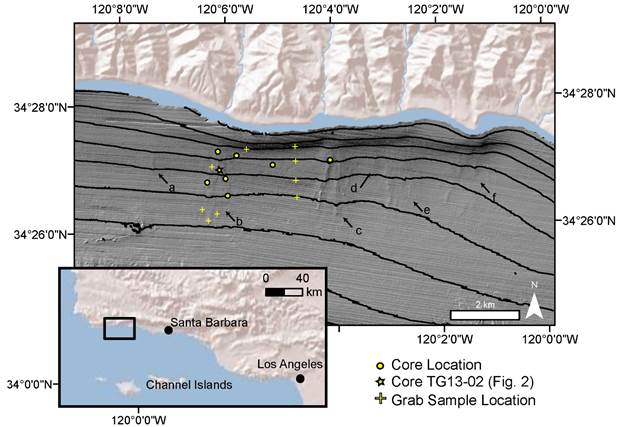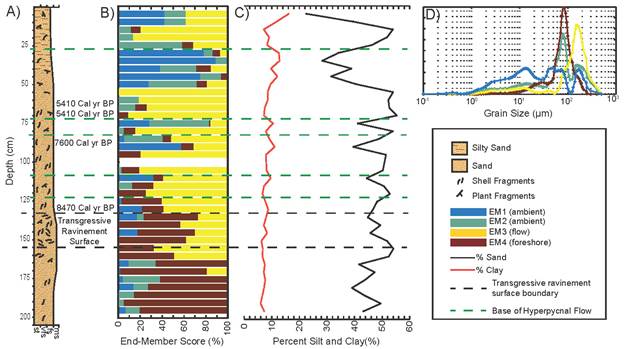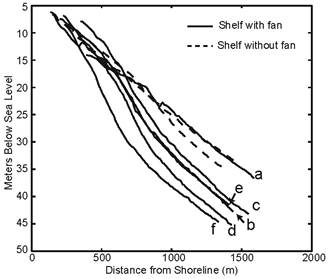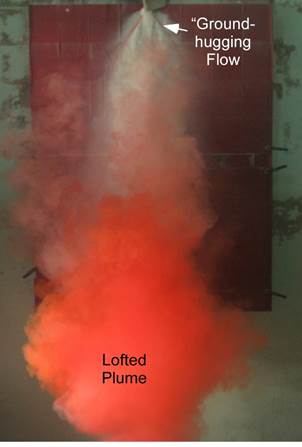Reports: ND852790-ND8: Hyperpycnal Subaqueous Fans of the Northern Santa Barbara Channel, Central California
Alexander R. Simms, PhD, University of California, Santa Barabara
The overall purpose of this grant is to study the morphology and deposits of recently imaged seafloor fans on the inner shelf of the Santa Barbara Channel. Our central hypothesis is that they are created by hyperpycnal flows. We have 3 major aims: 1.) map the distribution of one of these features using high-resolution seismic profiles, 2.) obtain grab samples, underwater camera images, and shallow cores to study the sedimentary characteristics of the deposits, and 3.) compare the petrology, grain size, and shape of the sedimentary deposits to sediments from the possible local sources. Over the past 12 months we have analyzed the ~50 km of seismic data, 8 cores, and 9 grab samples collected in the previous year (Fig. 1). This analysis included running grain-size, obtaining x-rays, describing the cores, and obtaining 14 radiocarbon dates from the cores. We have also sampled and characterized the local beach and stream sediments for a comparison with the fan sediments. In addition, we have added to our purely observational study of these fans by conducting a flume experiment to determine if we could replicate the deposits given the processes that we hypothesize are responsible for the seafloor fans.
As all of the deposits were generally composed of well-sorted medium to fine sand, we utilized an end-member modeling exercise on our grain-size data to statistically characterize 3 different facies: shoreface deposits, fan deposits, and off-fan deposits (Fig. 2). This characterization allowed us to positively identify the flow deposits. In conjunction with the new radiocarbon dates we found that the fan is active only occasionally - big flows occurring on centennial scales. Also, we were able to show that each lobe of the fans is composed of multiple flows and not one event. All flows occurred during Holocene times. In addition, we identified a transgressive ravinement surface within the cores that separates early Holocene shoreface deposits from the overlying fan deposits.
Our new results have allowed us to develop a model for the flows that explains their sedimentary characteristics. The fans are composed largely of flows that initially left the mouth of the river as hyperpycnal flows and transitioned into debris flows through flow separation in which the lighter material separates from the main flow and rises to the surface as a plume while the coarser material “freezes” as a debris flow on the seafloor (Fig. 3). This provides one of the first documented examples of “lofting” within Quaternary deposits. Such lofted flows have been observed experimentally and theoretically modelled but never observed in modern oceans. These deposits may provide an analogue for the many enigmatic sand beds within the ancient rock record (?) thought to represent turbidites but which lack typical Bouma-type sedimentary structures.
We have also found that shelf gradient plays a strong role in the formation of the seafloor fans as areas with gentler slopes along the channel appear to be devoid of these seafloor fans (Fig. 4). The steeper slopes that appear to be necessary for the formation of the fans appear to be related to the extent of the shoreface. We have further tested this idea by conducting some flume experiments at the University of Texas at Austin in conjunction with James Buttles and David Mohrig (Fig. 5). We have replicated the process and also found that fans formed from lofted flows appear (both in the seafloor fans of the Santa Barbara Channel as well as in the flume experiments) to have smaller width to length ratios than regular turbidite fans.
Our results were presented at the American Geophysical Union Fall meeting in December of 2014 as well as the Pacific Section of the American Association of Petroleum Geologists. Both presentations were first authored by Elisabeth Steel, the PhD student supported by this grant. We have also submitted our first manuscript for publication in a peer-reviewed journal.
Figures
Figure 1. Map showing the location of the sediment cores and sediment grab samples collected as part of this study. Also shown is the location of core TG13-02 whose description is shown in Figure 2.
Figure 2. Core TG13-02 description (A) including the results of the end-member analysis (B), textural analysis (C), and graph illustrating the grain-size distributions of the end-member grain-size curves (D).
Figure 3. Idealized models of a typical turbidity current and resulting turbidite and a lofting flow and its resulting sedimentary deposit.
Figure 4. Shelf slopes offshore from creeks with and without seafloor fans. See Figure 1 for fan locations.
Figure 5. A lofted flow within a flume.
















